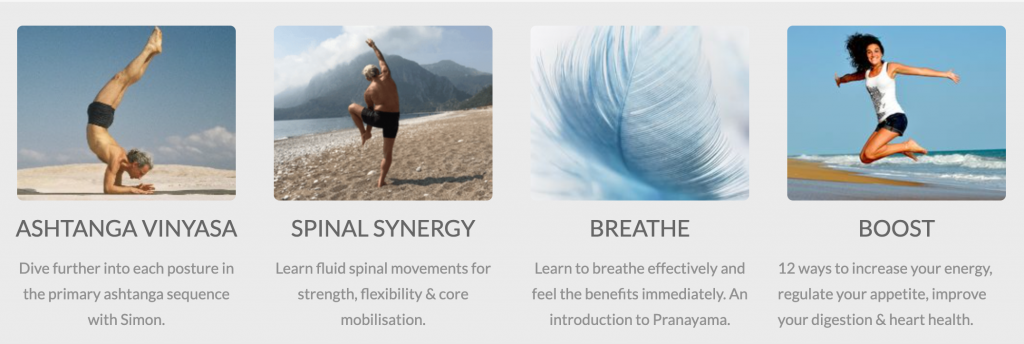
Simon Borg-Olivier doing Viparita Cakrasana (backward flipover) with antara kumbhaka (inhalation retention)
Although there are many benefits to learning how to use all the muscles of breathing, and to learn to breathe in many ways, in the more advanced stages of yoga it is the art of breathing less than normal (hypoventilation) that gives the most physiological benefits. The less you breathe in and out the more you will build up carbon dioxide inside your body. Contrary to popular belief, carbonic dioxide and the carbonic acid it becomes in your blood, has many benefits inside the body.
THE EFFECTS OF INCREASING CARBON DIOXIDE IN THE BODY: Carbon dioxide and carbonic acid build up inside you from breathing less than normal (mild hypoventilation):
*** brings more blood to your brain and heart (vasodilation)
*** allows more air to enter your lungs (bronchdilitation)
*** calms your nervous system
*** reduces your need and craving for heavy, processed and acid food
SIMPLE VERSION: For a beginner the best way to do get the benefits of a build up of carbon dioxide is to try to maintain relaxed abdominal breathing as much as possible and in as many activities as you can. A great activity is to go for a brisk walk and try to keep your breath as natural and relaxed as possible. You will find this easier to do if allow your abdomen to relax more than you may normally do and allow you hips and spine to move more freely like an olympic walker. For more advanced practitioners there are several other things you can do with your breath that can increase carbon dioxide once your body is adequately prepared.
ADVANCED VERSION (HOLDING THE BREATH IN): In this 5 minute video clip, which is an extract from the Yoga Synergy Yogic Nutrition video available online the benefits of holding your breath both in and out as an advanced yoga practitioner are elaborated and demonstrated.
In the first part of this video physiotherapist and research scientist Simon Borg-Olivier demonstrates how to use the Valsalva manoeuvre to lift into a handstand and do a backward flip (without warming up). Simon explains that the Valsalva manoeuvre is essentially the act of breathing in almost fully then holding your breath in and performing a moderately forceful attempt at exhalation (without actually exhaling) against your closed airway. Although this is a relatively commonly used technique for increasing strength via increasing intra-abdominal and intra-thoracic pressure in sports such a weightlifting, it is not recommended for most people as it can dangerously increase blood pressure and if done incorrectly can cause stroke in some people. Here Simon demonstrates how to use the Valsalva manoeuvre and what is essentially a chest lock (a compressive uddiyana bandha) and an abdominal lock (expansive mula bandha) (see our previous blog) to slowly lift his body into the air into a handstand. This method then also protects his lower back enough to drop into a full backward arch posture and then complete a backward flip to standing (viparita chakrasana). Here the Valsalva manoeuvre helps improve both strength and flexibility while protecting the lower back as well as other joints in the body. The added benefit of course is the build up of carbon dioxide in the body. Also, because of increased partial pressure of oxygen in the body this method also can give some of the benefits of hyperbaric oxygen therapy, which has been shown to have many healing effects by ‘pushing’ more oxygen into the tissues of the body.
WARNING: The Valsalva manoeuvre is potentially dangerous done in normal positions, but it is especially potentially dangerous when done in the exercise and movements shown in this video unless your body is highly trained in physical yoga and pranayama or at least similar Western exercise techniques. Many people (intentionally or unintentionally) use this method to do the ‘jump-back’ (lifting into lolasana) to the ‘push-up’ posture in ashtanga vinyasa yoga but this is not that safe and it is not what Sri Pattabhi Jois intended (please see below for the correct method). DO NOT use the Valsalva manoeuvre at all if you are prone to irregular blood pressure (high or low), headaches, nausea and/or circulatory system problem. If you do you use the Valsalva manoeuvre you must not let any pressure come to your head during the lifting movements of handstand and the backward flip. Pressing and keeping the tip of your tongue to the roof of the mouth can help to prevent excessive pressure going to the brain and helps to replace the standard chin-lock (ha-jalandhara bandha in pranayama), which is hard to do while lifting into handstands.
SAFE ALTERNATIVE (best for ashtanga vinyasa yoga): There is a far safer, more relaxing and in many ways more effective way to increase strength using increased intra-abdominal and intra-thoracic pressure. This is done by using your diaphragm to slowly breathe into your abdomen while you are lifting up your body into the air. In this case your abdomen should be firmed by correct pressure application in your posture. To lift slowly into a handstand (or lolasana) simply push the sitting bones and your navel down toward the floor instead of trying to push them upwards as many people do. This helps you to firm the abdomen using a combination of the same muscles you would use to do a sit up (rectus abdominis) and the muscles you would use for actively twisting the spine (internal and external abdominal oblique muscles). Breathing into the abdomen then increases the intra-abdominal pressure and intra-thoracic pressure making the handstand lift much easier, more stable for your back, more relaxing and without risking increased blood pressure. This method of inhaling while you lift into the air is the one that Sri Pattabhi Jois recommends in his ashtanga vinyasa yoga, during the lift (lolasana or ‘jump back’) to the ‘push-up’ position (chataranga dandasana) and which we have described in detail in another blog and also in our online courses.
ADVANCED VERSION (HOLDING THE BREATH OUT): In the second part of the video Simon talks about the benefits of holding your breath out. Here he demonstrates holding his breath completely out and practicing nauli (rectus abdominis isolation) and lauliki (abdominal churning using rectus abdominis as well as the oblique muscles) while expanding the chest as if inhaling to the chest but not actually inhaling. This practice, which is sometimes likened to the Mueller manoeuvre in Western medical science, builds up carbon dioxide even more rapidly than the Valsalva manoeuvre and is less dangerous to attempt. It is really great for improving digestion by massaging the internal organs. You can read more about this technique in our earlier blog.
Try a FREE Lecture
To learn more about this material please join one of our online courses. Try a FREE Lecture from any of our courses.
Advanced Yoga Fundamentals: Essentials for Teaching Yoga
Blending the science of physiotherapy and traditional yoga, you will learn the practical application of our ‘Anatomy and Physiology of Yoga’ course. For most people this is a more practical and more accessible course than ‘Anatomy and Physiology of Yoga’ and we recommend you do it first.
Our online course ‘Yoga Fundamentals:Essentials of Teacher Training: is a good complementary course for the ‘Anatomy and Physiology of Yoga’ Course as it’s not enough to know where your muscles and bones are, you also have to know what to do with them!
This is the public version of the award winning RMIT university course.
Our online course ‘Anatomy and Physiology of Yoga’ compares and contrasts the Eastern and Western approach to exercise and exercise therapy. This course also tries to explain the anatomy and physiology of yoga and other related eastern exercises (such as martial arts of China and India) using modern scientific language that is still accessible to the lay person.
Skill Building Online Courses
MORE POSTS BY SIMON BORG-OLIVIER
Share this Post



Comments 5
Thank you for all this sharing. I realy appreciate it. Namaste thomas
Author
Thanks for reading and sharing this everyone. I have just re-edited the post to point out following things.
Although I have warned beginners not to practice the Valsalva manoeuvre in postures, it can help improve both strength and flexibility while protecting the lower back and other joints, as well as building up carbon dioxide, which has all the benefits listed in the blog. Also, because of increased partial pressure of oxygen in the body this method also can give some of the benefits of hyperbaric oxygen therapy, which has been shown to have many healing effects by ‘pushing’ more oxygen into the tissues of the body.
In fact many people (intentionally or unintentionally) use the Valsalva manoeuvre to do the ‘jump-back’ (lifting into lolasana) to the ‘push-up’ posture in ashtanga vinyasa yoga, but this is potentially not that safe to do for reasons mentioned in our blog and it is not what Sri Pattabhi Jois intended.
There is a far safer, more relaxing and in many ways more effective way to increase strength and protect you back for yoga (and even weightlifting) using increased intra-abdominal and intra-thoracic pressure. This is done by using your diaphragm to slowly breathe into your abdomen while you are lifting up your body (or a weight)into the air. In this case your abdomen should be firmed by correct pressure application in your posture.
To lift slowly into a handstand (or lolasana) simply push the sitting bones and your navel down toward the floor instead of trying to push them upwards as many people do. This helps you to firm the abdomen using a combination of the same muscles you would use to do a sit up (rectus abdominis) and the muscles you would use for actively twisting the spine (internal and external abdominal oblique muscles). Breathing into the abdomen then increases the intra-abdominal pressure and intra-thoracic pressure making the handstand lift much easier, more relaxing and without risking increased blood pressure. This method of inhaling while you lift into the air is the one that Sri Pattabhi Jois recommends in his ashtanga vinyasa yoga, during the lift (lolasana or ‘jump back’) to the ‘push-up’ position (chataranga dandasana).
Healthy food is beneficial to all those who are doing regular exercise nice post.
All true Simon… truly oxygenate your skin!More CO2 in the blood prompts haemoglobin to lose oxygen to the tissues at cellular level…
Incidentally, cold showers can also do this: haemoglobin is put under more pressure at capillary level & O2 is squeezed off (into the tissues).
For me, yoga is a system designed to help down regulate the automatic breath rate & train stress tolerance.
As you know, Russian physiologist Dr Konstantin Buteyko described this in the 1950’s.
Author
hi Catherine – thank you for your comment – i totally agree with you